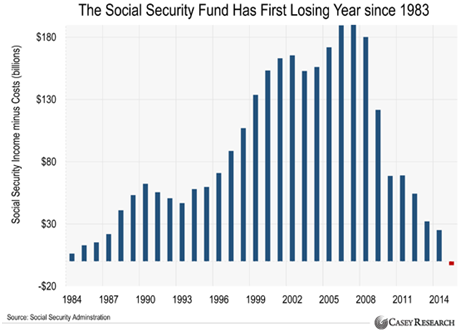
Social Security funds are drying up…will there be any money left when you retire?
Social Security is America’s largest federal program. In 2015, it paid out $870 billion to more than 59 million Americans.
Most Americans see Social Security as a retirement savings program. During your working life, you pay 6.2% of every paycheck to Social Security. In return, the government sends you a check every month after you retire.
However, unlike a retirement plan like a 401(k), the money you pay into Social Security doesn’t land in your own personal account. Instead, it goes into one big pot called the “Social Security Trust Fund.”
The Social Security program pays retirees from this pot. As long as enough money flows into the pot, the program works, and retired people get the payments they expect.
• Last year, the Social Security Trust Fund lost money…
On Wednesday, Investor’s Business Daily reported (emphasis ours):
The Social Security Trust Fund just suffered its first annual decline since Congress shored up the retirement program in 1983.
The unexpected $3 billion decline is an indication of the precarious state of Social Security's finances. Since 2010, the program has been paying out more in benefits than it gets in tax revenue.
In 1955, there were 8.6 workers paying into Social Security for every one person receiving Social Security. Today, due to America’s aging population, there are just 2.8 workers for every recipient. And that number will decline as the “baby boomer” generation continues to retire.
The Congressional Budget Office (CBO) expects Social Security to go broke within 13 years, according to Investor’s Business Daily.
Social Security's cash shortfall is expected to rapidly escalate from $74 billion a year to $361 billion in 2025 alone, the Congressional Budget Office projects. Under current policies, the CBO says the trust fund will be gone by 2029.
• To fix Social Security, the government would need to cut benefits by 29%...
According to Investor’s Business Daily, this would bring the program’s costs in line with how much money it takes in.
The average retiree receives $1,355 each month from Social Security. A 29% cut would reduce that to $962 per month.
That’s not going to happen. Because senior citizens are a huge voting bloc, most politicians consider Social Security benefits to be untouchable.
• The U.S. government will continue to make promises it can’t keep…
To keep the scheme going, Washington will run bigger deficits. It will go deeper into debt.
Longtime readers know the U.S. government is drowning in debt. The federal government already owes more than $18 trillion. That’s 129% more than it owed a decade ago.
The federal debt is now bigger than the yearly output of the entire U.S. economy. The current debt-to-GDP ratio is 101%, the highest since World War II.
Programs like Social Security helped cause this financial wreck. Today, $0.72 of every dollar the government spends goes to entitlement programs like Social Security. In 1970, only $0.28 of every dollar went to entitlement programs.
• Casey Research founder Doug Casey says Social Security is a “gigantic Ponzi scheme.”
He says it’s “nothing but a vague promise backed by nothing but an impossibly debt-ridden government with financial problems that are about to get much worse.”
Here’s Doug.
By taking almost 15% of a person's wages right off the top, Social Security makes it much harder for a poor person to save money. Worse yet, it makes people think they don't need to save for themselves; it gives them a false sense of security. Even worse is that the money never really belongs to the presumed recipient; it's simply another unsecured obligation of a bankrupt government.
Doug says millions of Americans who expect Social Security income won’t get it. He believes the Social Security program should be eradicated.
• We don’t expect the government to fix Social Security...
If you’re under the age of 50, you’ll probably never get a dime in Social Security payments.
However, we doubt Social Security will go away quietly. The government will likely try to “fix” it the only way it knows how: by printing and borrowing money.
As we mentioned earlier, the U.S. government is already drowning in debt. Printing and borrowing billions more to fix Social Security could wreck the economy. Or worse, it could destroy the U.S. dollar.
If you keep a significant portion of your money in assets tied to the U.S. dollar, we recommend watching this free video. It contains all of Casey Research’s best advice on how to protect your money from a U.S. dollar collapse. Click here to watch.
Chart of the Day
The Social Security Trust Fund lost money last year…
Today’s chart shows the Social Security Trust Fund’s annual cash flows. As you can see, the fund took in more money than it paid out every year from 1984–2014.
However, in 2015, the fund handed out $3 billion more than it received. It was the fund’s first deficit since 1983.
Unless the government reforms Social Security, the Congressional Budget Office says the fund will run out of money by 2029.
